Henry Diltz Tours His Rock Photo Exhibit at L.A. Morrison Hotel Gallery
by Stephen K Peeples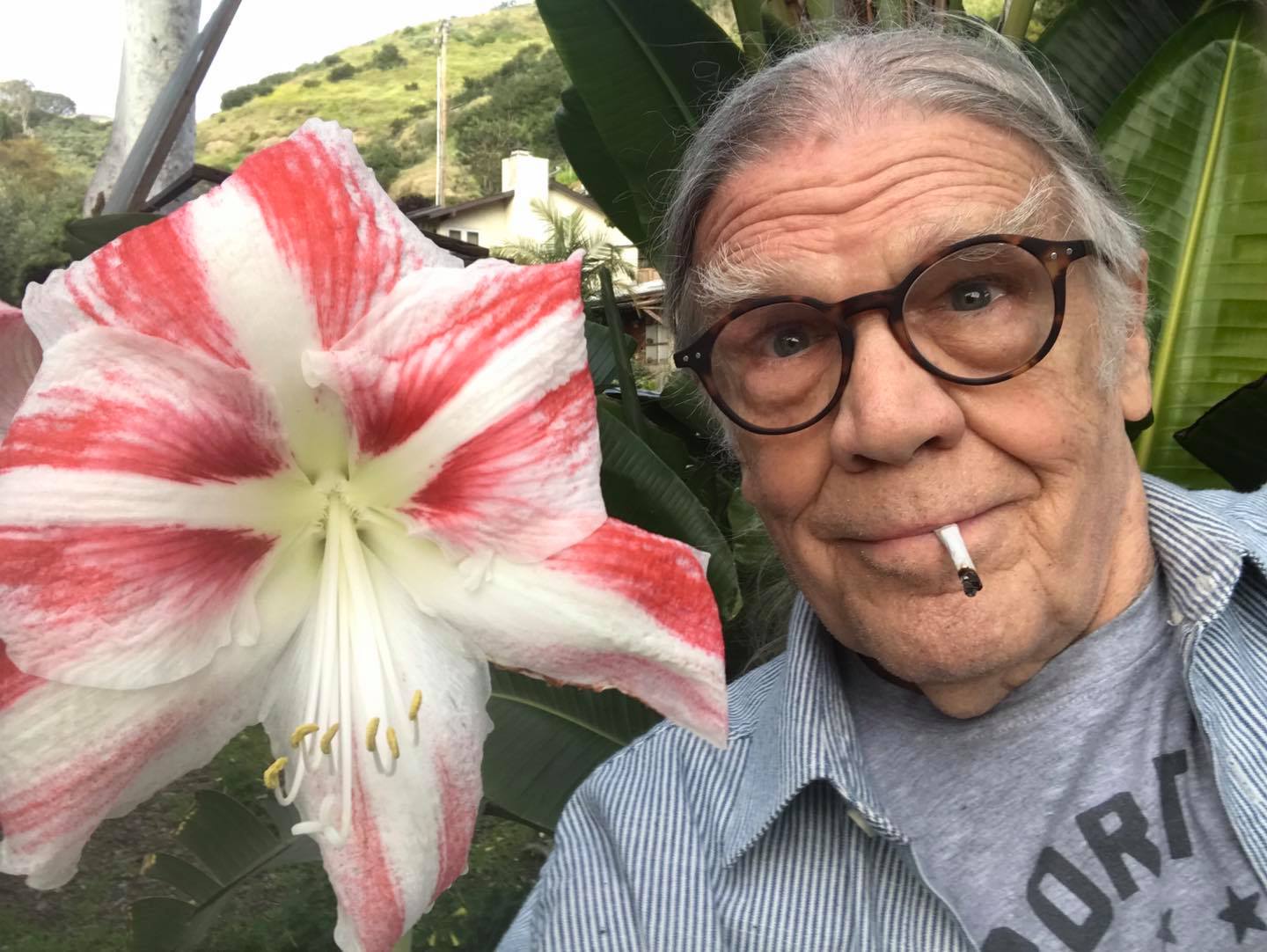 Legendary music photographer Henry Diltz was honored by the Recording Academy on Feb. 4, 2023, as one of the recipients of the organization’s prestigious Trustees Awards.
Legendary music photographer Henry Diltz was honored by the Recording Academy on Feb. 4, 2023, as one of the recipients of the organization’s prestigious Trustees Awards.
Last fall, the Morrison Hotel Gallery presented a rare solo exhibit, “BE MUSED: Retrospecting the Inspired Life & Legendary Archive of Henry Diltz,” at its West Hollywood location featuring iconic photographs by Diltz, one of the Gallery’s co-founders.
Diltz photographed more than 250 album covers and thousands of publicity shots in the 1960s and 1970s, including the iconic Morrison Hotel cover for the Doors. Other artists, whose fly-on-the-wall style portraits he’s known for, include musical legends such as Eagles, Neil Young, Crosby, Stills & Nash, Jackson Browne, America, Steppenwolf, James Taylor, Jimi Hendrix, The Monkees, Joni Mitchell, Linda Ronstadt, and David Cassidy. He was the official photographer at the Woodstock festival in August 1969. His work has appeared in The New York Times, Los Angeles Times, LIFE, People, Rolling Stone, High Times, and Billboard.
The “BE MUSED” exhibit displayed a carefully curated selection of images spanning the six decades he has been documenting pop culture from behind the lens. The exhibit mirrored the summer 2022 Diltz retrospective at Morrison Hotel Gallery’s New York City location in SoHo. Diltz and partners Peter Blachley, Rich Horowitz and Timothy White also operate a third MHG on Maui. In the following clips, Diltz walks through the exhibit with Stephen K. Peeples, a Grammy-nominated producer and longtime friend and collaborator.
In an early October conversation, the ever-affable, much-loved and respected lensman and storyteller said he was excited about his upcoming exhibit because it has been years… YEARS…since he’s had a solo show at the West Coast gallery.
“When we opened up the first little Morrison Hotel Gallery in SoHo 22 years ago, I was the only photographer,” Diltz said. “My two pals Peter and Rich and I had traveled around a little and had pop-up [sales] before that, but then we said, ‘Let’s start to sell these in a gallery. Let’s get a little place, just for my pictures.’
“So, I would go into the gallery and there would be 40, 50, 60 pictures, only mine, on the wall, and I loved that,” he said. “People would walk in and say, ‘Oh, my God! This is my whole life!’ — especially if they came from Laurel Canyon.

Cover photo shot at a downtown Los Angeles flophouse for The Doors’ Morrison Hotel album, released February 1970. (Photo © Henry Diltz/Henry Diltz Photography. Used with permission)
“But today, the Morrison Hotel Gallery has three locations and represents 125 photographers — maybe even more. So, usually, when I go to a show in one of our galleries, I’m lucky to have one or two pictures on the wall.”
Watch more of Diltz’s tour of his 2022 exhibition
The Accidental Photographer
Diltz, who turned 84 on September 6, segued from world-traveled college student to banjo-picking Modern Folk Quartet co-founder in the early 1960s, and a few years later to in-demand rock photographer — almost by accident.

Cass Elliot in the California desert on June 11, 1968, miles from Laurel Canyon, in a shoot with art director Gary Burden. (Photo © Henry Diltz/Henry Diltz Photography. Used with permission)
As detailed on Best Classic Bands and in a biographical feature by this writer for Diltz’s 2011 book, Unpainted Faces, MFQ was on its farewell tour in mid-1966 when he bought a used camera and some slide film at a thrift shop. He started shooting cool objects and random candids of his not-yet-famous musician friends, including his bandmates and various neighbors in Laurel Canyon, just for practice, and slideshows.
Rock photography soon became his full-time career as many of those friends became famous, and teen music fanzines hit him up for photos of their groups, like the Lovin’ Spoonful, Buffalo Springfield and the Monkees.

Joni Mitchell, David Crosby, Owen Elliot, and Eric Clapton, at the home of Cass Elliot, who Henry Diltz fondly remembers as “the Gertrude Stein of Laurel Canyon,” on February 25, 1968. Owen, Cass’ daughter, cavorted on the lawn as Mitchell played and sang. Clapton, in L.A. for Cream’s farewell concert and on his first visit to the Canyon, was transfixed by Mitchell’s unorthodox guitar tunings. Crosby proffered a joint of his famously high-quality herb to the photographer. (Photo © Henry Diltz/Henry Diltz Photography. Used with permission)
Diltz’s images have graced more than 200 album covers, the first being Hums of the Lovin’ Spoonful in November 1966, and innumerable books, magazine covers and articles, film and video documentaries, and web posts.

Goldmine magazine’s August/September 2022 Woodstock flashback issue featured a cover photo of John Sebastian by Henry Diltz and other Diltz photos and journal entries inside
Diltz was the official photographer for the Monterey International Pop Festival in June 1967, the second Miami Pop Festival in 1968, and all three Woodstock festivals (1969, 1994 and 1999).
In addition to “Under the Covers,” his 1996 CD-ROM with art director partner Gary Burden (produced by Peter Blachley, later one of Henry’s Morrison Hotel Gallery co-founders), Diltz has appeared in countless film and television documentaries about the ’60s rock scene in L.A., especially docs focusing on Laurel Canyon. And he has shared behind-the-scenes rock ‘n’ roll stories with who-knows-how-many radio and TV hosts.
Diltz’s work is renowned worldwide, including Japan, where photographers and music fans alike treat him like the rock stars he’s photographed. Diltz was the 2020 International Photography Hall of Fame Lifetime Achievement honoree, and so far this year, he’s been engaged to present several slideshow events in Europe as well as the States.
Today, the Henry Diltz Photography archive includes images of America, B.B. King, Chuck Berry, Blondie, Booker T. & the MG’s, Garth Brooks, Jackson Browne, Jimmy Buffett, Buffalo Springfield, the Byrds, Glen Campbell, Canned Heat, Truman Capote, David Cassidy, Eric Clapton, Ray Charles, Joe Cocker, Elvis Costello, Crazy Horse, David Crosby, Crosby, Stills, Nash & Young, Martha Davis and the Motels, the Doors, Denny Doherty, Bob Dylan, Eagles, Cass Elliot, Dan Fogelberg, Glenn Frey, Jerry Garcia, Arlo Guthrie, Tim Hardin, Emmylou Harris, George Harrison, Richie Havens, Don Henley, Chris Hillman, Fleetwood Mac, Jimi Hendrix, the Hollies, Bob Hope, Michael Jackson, the Jackson 5, Mick Jagger, Jefferson Airplane, Janis Joplin, Led Zeppelin, the Lovin’ Spoonful, the Mamas & the Papas; Paul McCartney, Joni Mitchell, the Monkees, Jim Morrison, Maria Muldaur, Jack Nicholson, Nirvana, Pearl Jam, Tom Petty & the Heartbreakers, Michelle Phillips, John Phillips, Robert Plant, Richard Pryor, Bonnie Raitt, Lou Reed, Keith Richards, Ringo Starr, the Rolling Stones, Linda Ronstadt, Arnold Schwarzenegger, John Sebastian, Pete Seeger, Bob Seger, Grace Slick, Sly & the Family Stone, J.D. Souther, Bruce Springsteen, Ringo Starr, Steely Dan, Steppenwolf, Rod Stewart, John Stewart, Stephen Stills, Sting, James Taylor, Tina Turner, the Turtles, Steven Tyler, Tom Waits, Joe Walsh, John Wayne, Jimmy Webb, Leslie West, the Who, Johnny Winter, Thom Yorke, Neil Young, Frank Zappa & the Mothers of Invention, Warren Zevon and many others.
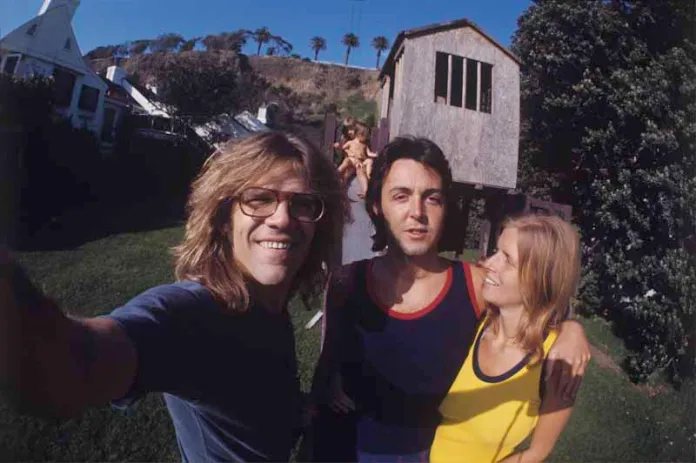
Henry Diltz snaps a selfie with Paul and Linda McCartney, April 5, 1971. A photo of the couple from this session appeared on the cover of LIFE Magazine. (Photo © Henry Diltz/Henry Diltz Photography. Used with permission)
In our October 2022 conversation, Diltz shared further thoughts about why and how he does what he does. He said curiosity is the force that has driven him since childhood. I noted numerous other creative types have told me the same thing over the last 50 years, among them our mutual friend Texas artlaw Boyd Elder, who Diltz introduced me to in early 1978…
Stephen Peeples: Curiosity — that seems to be the fuel that keeps the creative fire burning. Boyd said as a kid, he was just full of “wanna-know.”
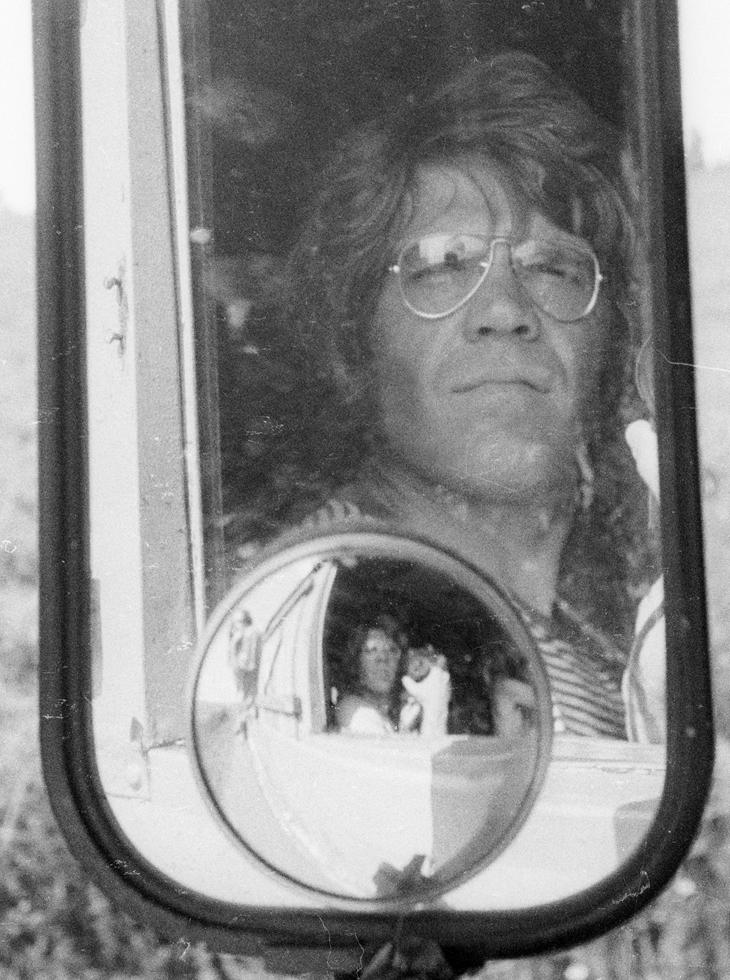
Henry Diltz shoots his reflection(s) in a vehicle’s rearview mirror at Woodstock, August 7, 1969. (Photo © Henry Diltz/Henry Diltz Photography. Used with permission)
Henry Diltz: Wanna-know. Yeah, that’s a good one. For me, first, I’m very curious about life. What is this we find ourselves in the middle of? What, and why, and how? All those questions. You learn. That’s what you learn your whole life. It’s a process, a progression of learning.
Second, I’m very curious about people. That’s why I was a psychology major in college: “What makes people tick? What makes them act the way they do? What makes us all different and all the same?” All of that was, and still is, very interesting to me.
But then yesterday, I was driving along, and at a red light, saw a shadow on a wall of a tree. I was grabbing for my camera quickly to take it before the light changed, thinking, “I’ve got to have that.” Then I asked myself, “Wow, what drove me to want to do that?”
It may or may not be an extension of that curiosity, but visual cues are very important to me: the shadow of something, the way some bricks are laid, or how colors line up next to each other.
It’s about the visual cues, the graphic cues. It’s why I like different-colored fire hydrants, manhole covers, signs and tattoos, graffiti, all those little stickers you find plastered on phone poles these days.
This is all stuff we see in our daily life. Some of it appeals to me, some doesn’t. When it does, I know it. I say, “Oh, shit, I’ve got to take that!”
License plates: I love to photograph license plates. Today, I took one. I was so happy I got it before the light changed. It said, “Hi and by.” H-I, A-N-D, B-Y, with spaces between them. I loved that.
It’s the collection of them that’s interesting. Just that one alone is okay, but if you have 10 or 20, it becomes something else.
This all stems from my early days of photography when I ended up entertaining my stoned hippie friends with a slideshow. The best way to do that would be to have a series of things. Again, you could have a picture of one thing, but if you have three or four, you have a theme, you can show the bigger picture.
In the beginning, it was my friends [and neighbors in Laurel Canyon]. I always hang out with my friends. We all do. But while I hung out with my karmic friends, I would sneak pictures of them, and then on the weekend, I’d show them in the slide show. When people said, “Oh, my God! I didn’t even know you took that!” — that was the best thing.
But I would just take pictures of my friends, and after a few weeks, I would get maybe three or four people, say, eating, just by accident. Eating or sleeping, taking a nap, or reading a book.
Those led to slideshows like the reading series, the sleeping series, the eating series. It started that way. The thematic thing made it more entertaining.
Then as I traveled around the country with rock groups, first with The Lovin’ Spoonful [on their 1966 tour] — fire hydrants. Every little town in the Midwest has a different colored fire hydrant. They’re not all red. In fact, in L.A., there are no red ones. They’re all yellow. New York, they’re black and silver. But in other places they’re green, or orange, or blue, or green and blue. In San Francisco, they’re white and a beautiful light blue on top.
So, I noticed that. It’s my Virgo nature, I suppose. I analyze, make lists. I see these things sequentially and put them together.
T-shirts was a common theme. Tattoos, certainly. Right now, I love to take pictures of women’s colorful fingernails. Those inanimate things are about half my archive. The other half is people and music. That’s the part we’re talking about.
Off-the-wall stuff on Instagram maybe helps your work bridge the generations…
Everywhere I go, all kinds of people say, “Oh, man, I love following you on Instagram, and I love your little factoids. I love your little history bits.”
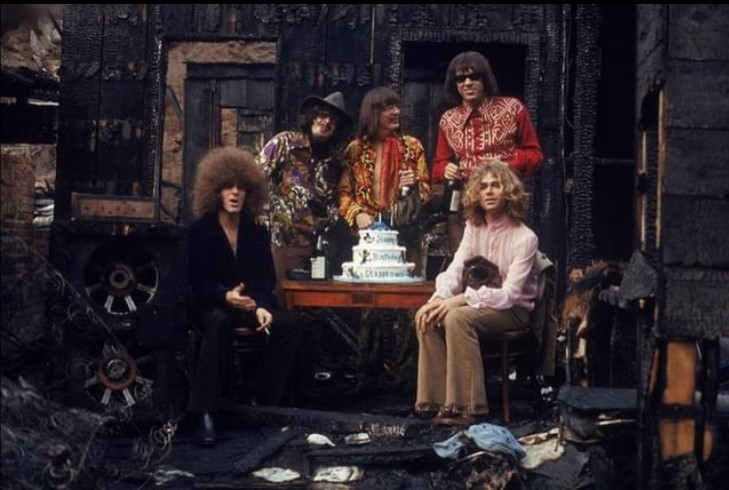
Henry Diltz: “This was a photoshoot with Steppenwolf for their album ‘At Your Birthday Party’ on December 10, 1968. We photographed them in a little burned-down cabin next to Joni Mitchell’s house in Laurel Canyon. Michael Monarch (lead guitarist) couldn’t make it that day, so their producer, Gabriel Mekler (in the hat) stood in for him.” (Photo © Henry Diltz/Henry Diltz Photography. Used with permission)
I am not a guy who makes a photo. I’m a documentary guy. I like to watch people, what they’re doing, until I think it’s really interesting, visually or how they fill the frame, or if there’s a moment of hilarity and they’re laughing, I see it and just push the button.

Joni Mitchell and Graham Nash share an intimate moment, comfortable with, oblivious to, or both, their fellow Laurel Canyon musician friend and his camera. They were riding in a limo en route to Big Bear in the mountains east of Los Angeles to shoot the center spread photo for the first Crosby, Stills & Nash album on February 17, 1969. (Photo © Henry Diltz/Henry Diltz Photography. Used with permission)
I could catch people in candid moments because I wasn’t in their faces. I never did get in and tell people what to do. I’d never want to be the guy who says, “Okay, stand over there, put your arm up in the air. Say cheese!” I would quietly watch, sitting there quietly, not drawing attention to myself, like that tiger in the bush, just quietly watching for those moments. I wasn’t looking for dinner, though — just a good photo.
I also consider myself an existentialist. I took a class called existentialism in college that was mostly Kierkegaard, but the fact is, we live in the moment: The past is past, the future hasn’t occurred yet, so what’s real is this exact moment.
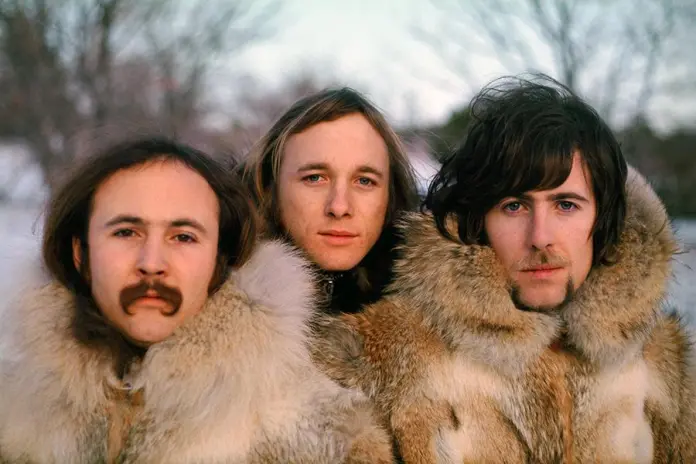
David Crosby, Stephen Stills, and Graham Nash get warm and fuzzy in Big Bear, February 1969. (Photo © Henry Diltz/Henry Diltz Photography. Used with permission)
Years ago, I thought, “I feel like an existentialist, but I’m known for these past moments. That doesn’t really sit well because I’m more of a now guy. This is the moment.” Then somebody said, “Well, yeah, but you bring the past moments into the present.” I thought, “Oh, okay. I can live with that.”
So, mine is really a documentary style. I like to catch people in a real moment. That’s what it is. That’s my curiosity.”
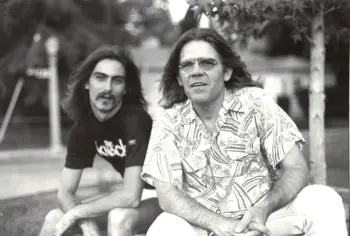
Henry Diltz (R) and Stephen K. Peeples, Studio City, 1979. (Photo: Ruth Peeples)
Special thanks to Henry Diltz, Henry Diltz Photography, Gary Strobl, the Morrison Hotel Gallery, Paige Califano, and Chloe Gonzalez/The Press House.
For more info about Morrison Hotel Gallery, contact Chloe Gonzalez at The Press House, 760-936-7143 or chloe@thepresshouse.com.
To inquire about purchasing prints of Henry Diltz’s photos, contact Paige Califano at 862- 266-2933 or paige@morrisonhotelgallery.com.

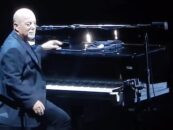
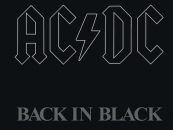

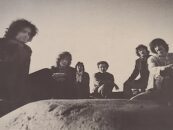

1 Comment so far
Jump into a conversationgreat work, stephen… hope to see more of you at this GREAT site!